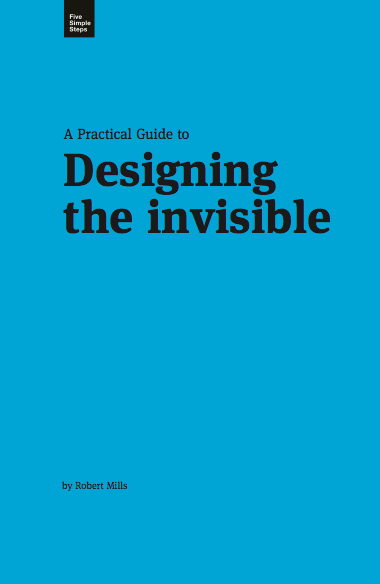This content originally appeared on Laura Kalbag’s Blog Posts and was authored by Laura Kalbag
After reading Mark Boulton’s A Practical Guide to Designing For The Web and Andy Clarke’s Hardboiled Web Design, I was keen to read another Five Simple Steps’ design book. Robert Mills’ A Practical Guide to Designing the invisible definitely didn’t disappoint.

It took me a few reads to start getting into it. I haven’t been dedicating enough time to reading lately, so when I did it was stop-start and not concentrating properly, so I’ve decided to read a chapter a day. The idea behind this is to inspire me and set me up for the day’s work. It also allows me to catch up on my huge pile of unread books and learn a little on the way.
A Practical Guide to Designing the invisible was my first book to read in this way. It is perfectly divided into five parts, which allowed me to read it one-part-a-day each weekday last week. It took me around twenty to twenty-five minutes to read each part. These are:
- Invisible communication 101
- Following the right signs
- Using the right palette
- Using the correct language
- Telling the best story
Each part is well-crafted; starting with a overview explaining why that area is an important part of designing a website, followed by more in-depth principles and examples, finished off with a real-life case study allowing the reader to see how those principles can be applied. The abstract-to-real-life structure combines theoretical and more practical information in an easy-to-digest way.
A Practical Guide to Designing the invisible is sold as a book aimed at beginners and non-designers:
This book is for design beginners. If you’re not a designer but sometimes are asked to do design, then this book is for you.
I’d agree that it is perfect for this audience, but Robert Mills doesn’t write in a basic way, and it certainly isn’t patronising. I was actually surprised at the amount of detail that Robert went into on some of the theory. For example, the section on semiotics was probably about as much depth as I learnt in my first year at university studying Digital Design/Graphic Communication. This continued through the book, it frequently reminded me of Graphic Design at university and college, but with that vital web context and angle. I think this book would be a perfect read for any designers looking to catch up on the theory they might have missed by not studying design, and any developers or business people wanting to better understand design from a designer’s point of view.
As a fairly experienced designer, and has had a more formal ‘design education’, I still found it valuable. It reminded me of the reasoning behind my design work. I think it gets to a point where some of your own design work can be on a subconscious ‘invisible’ level, and this helped me identify some of the principles I use every day, and how best I can explain and justify my design choices.
The only slight downside to A Practical Guide to Designing the invisible was the digital format. I can find it tricky to concentrate when reading on my desktop screen, as I get easily distracted by background tasks, but you can easily read this book across devices in the formats provided. The only downside to trying to read on other devices, particularly those with smaller screens, is that the layout of the book is very much designed for print. As a digital-only book, I feel it could have benefited from less margin space and a slightly larger x-height with a more hierarchical layout (fewer pull-outs), making the images more directly follow the relevant text to optimise for a screen-based reading experience.
In conclusion, it’s a good one, buy it! A book that covers web design well and doesn’t mention HTML and CSS is a rare find (this can date a book quickly and design principles can get lost in the markup) and I’ll definitely be recommending it to any future person who asks me what to read if they want to be a designer. ## 3 comments
-
Bought (you should get referrals)
-
I just read Hardboiled Web Design. I was going to pick this up to, but I have this thing about buying books and not actually getting a ‘book’. Maybe I’ll give it a read after this review!
-
Read the original post, 'A Practical Guide to Designing the invisible'.
This content originally appeared on Laura Kalbag’s Blog Posts and was authored by Laura Kalbag
Laura Kalbag | Sciencx (2011-11-01T08:27:28+00:00) A Practical Guide to Designing the invisible. Retrieved from https://www.scien.cx/2011/11/01/a-practical-guide-to-designing-the-invisible/
Please log in to upload a file.
There are no updates yet.
Click the Upload button above to add an update.
